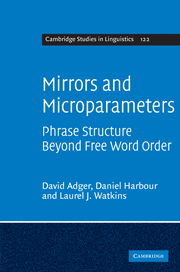Book contents
- Frontmatter
- Contents
- List of tables
- Acknowledgements
- Abbreviations and notation
- Kiowa phonemes and orthography
- 1 Introduction
- 2 Nonconfigurationality and polysynthesis
- 3 The clausal spine
- 4 Making mirrors
- 5 Interface properties of clausal domains
- 6 Anti-quantification and the syntax–semantics interface
- 7 Conclusion
- Appendix
- References
- Index
1 - Introduction
Published online by Cambridge University Press: 26 January 2010
- Frontmatter
- Contents
- List of tables
- Acknowledgements
- Abbreviations and notation
- Kiowa phonemes and orthography
- 1 Introduction
- 2 Nonconfigurationality and polysynthesis
- 3 The clausal spine
- 4 Making mirrors
- 5 Interface properties of clausal domains
- 6 Anti-quantification and the syntax–semantics interface
- 7 Conclusion
- Appendix
- References
- Index
Summary
What this book is about
There is a difference between liberty and anarchy. Liberty is freedom from some constraints; anarchy is the absence of all. Nonconfigurationality, defined as the confluence of radical pro-drop, freedom of word order and noncontiguity of (sub)constituents, seems to represent the anarchic end of the linguistic spectrum. What is missing from current studies is the search for order beyond these three simple criteria. In this book, we tackle this issue through the detailed study of one particular nonconfigurational language, showing that robust configurational effects, familiar from other languages, lie beyond the scope of the three definitional criteria. This holds important implications for linguistic theory as it entails that the deep phrasal architecture of nonconfigurational languages does not differ radically from that of more commonly studied ones.
We will show that Kiowa, our language of study, has radical pro-drop, extremely free argument order, and free splitting of constituents. These are the hallmarks of nonconfigurationality. However, Kiowa exhibits three major configurational restrictions and the interplay between these and Kiowa's nonconfigurational properties is important for how we understand crosslinguistic variation, syntactic structure and the nature of the syntactic interfaces. The generalizations all involve mirroring of hierarchies around the axis of the verb. In one case, preverbal particles and postverbal suffixes have inverse orders; in another case, postverbal constituents are rigidly bound in the reverse of their default (hierarchically induced) order; and in the last case, one and the same set of focus-marked and quantificational elements is banned from the pre- and postverbal extremities.
In deriving these generalizations, we develop a theory of clause structure with several important ramifications.
- Type
- Chapter
- Information
- Mirrors and MicroparametersPhrase Structure beyond Free Word Order, pp. 1 - 24Publisher: Cambridge University PressPrint publication year: 2009



